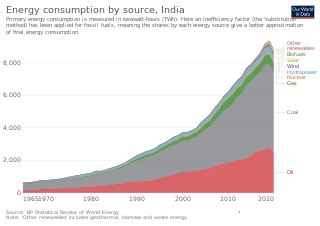
The economy of Gabon is characterized by strong links with France, large foreign investments, dependence on skilled foreign labor, and decline of agriculture. Gabon on paper enjoys a per capita income four times that of most nations of sub-Saharan Africa/higher than North African countries, but its reliance on resource extraction industry fail to release much of the population from extreme poverty, as much of 30% of the population lives under the poverty threshold.

Liquefied petroleum gas is a fuel gas which contains a flammable mixture of hydrocarbon gases, specifically propane, propylene, butylene, isobutane, and n-butane.
This is a list of lists of countries and territories by various criteria. A country or territory is a geographical area, either in the sense of nation or state.

Energy in the United States is obtained from a diverse portfolio of sources, although the majority came from fossil fuels in 2021, as 36% of the nation's energy originated from petroleum, 32% from natural gas, and 11% from coal. Electricity from nuclear power supplied 8% and renewable energy supplied 12%, which includes biomass, wind, hydro, solar and geothermal.

The natural environment, commonly referred to simply as the environment, is all living and non-living things that occur naturally on Earth or some part of it. This includes complete ecological units that function as natural systems without massive human intervention, including all vegetation, animals, microorganisms, rocks, atmosphere and natural phenomena that occur within their boundaries. And it includes universal natural resources and physical phenomena that lack clear-cut boundaries, such as air, water, and climate, as well as energy, radiation, electric charge, and magnetism, not originating from human activity.
The energy policy of India is to increase the locally produced energy in India and reduce energy poverty, with more focus on developing alternative sources of energy, particularly nuclear, solar and wind energy. Net energy import dependency was 40.9% in 2021-22.

Iran has the fourth largest oil reserves and the 2nd largest natural gas reserves in the world. The nation is a member of OPEC, and generates approximately 50% of state revenue through oil exports.

Since 2013, total primary energy consumption in India has been the third highest in the world after China and United States. India is the second-top coal consumer in the year 2017 after China. India ranks third in oil consumption with 22.1 crore tons in 2017 after United States and China. India is net energy importer to meet nearly 47% of its total primary energy in 2019.

This article includes a chart representing proven reserves, production, consumption, exports and imports of natural gas by country. Below the numbers there is specified which position a country holds by the corresponding parameter. Dependent territories, not fully recognized countries and supranational entities are not ranked. By default countries are ranked by their total proven natural gas reserves.

Energy in Italy comes mostly from fossil fuels. Among the most used resources are petroleum, natural gas, coal and renewables. Italy has few energy resources, and most supplies are imported.

Between 2009 and 2014, gas consumption, production, and imports in China have grown dramatically, with two-digit growth. According to CNPC, the installed capacity of gas-fired power plants in the country is expected to reach around 138 million-154 million kilowatts in 2025, and further grow to 261 million-308 million kilowatts by 2030.

Primary energy consumption in Spain in 2015 was mainly composed of fossil fuels. The largest sources are petroleum (42.3%), natural gas (19.8%) and coal (11.6%). The remaining 26.3% is accounted for by nuclear energy (12%) and different renewable energy sources (14.3%). Domestic production of primary energy includes nuclear (44,8%), solar, wind and geothermal (22,4%), biomass and waste (21,1%), hydropower (7,2%) and fossil (4,5%).

Energy in Belarus describes energy and electricity production, consumption and import in Belarus. Belarus is a net energy importer. According to IEA, the energy import vastly exceeded the energy production in 2015, describing Belarus as one of the world's least energy sufficient countries in the world. Belarus is very dependent on Russia.

The Yuzivska gas field is an unconventional Ukrainian natural gas field that was discovered in 2010. It was expected to begin production in 2017, but development was halted because of the outbreak of the 2014 war in the Donbas region near the field, a sharp plunge in European natural gas prices, and opposition from local residents.

The total primary energy consumption of the Philippines in 2012 was 30.2 Mtoe, most of which came from fossil fuels. Electricity consumption in 2010 was 64.52 TWh, of which almost two-thirds came from fossil fuels, 21% from hydroelectric plants, and 13% from other renewable sources. The total generating capacity was 16.36 GW.

World energy supply and consumption refers to the global primary energy production, energy conversion and trade, and final consumption of energy. Energy can be used in various different forms, as processed fuels or electricity, or for various different purposes, like for transportation or electricity generation. Energy production and consumption are an important part of the economy. This topic includes heat, but not energy from food.













